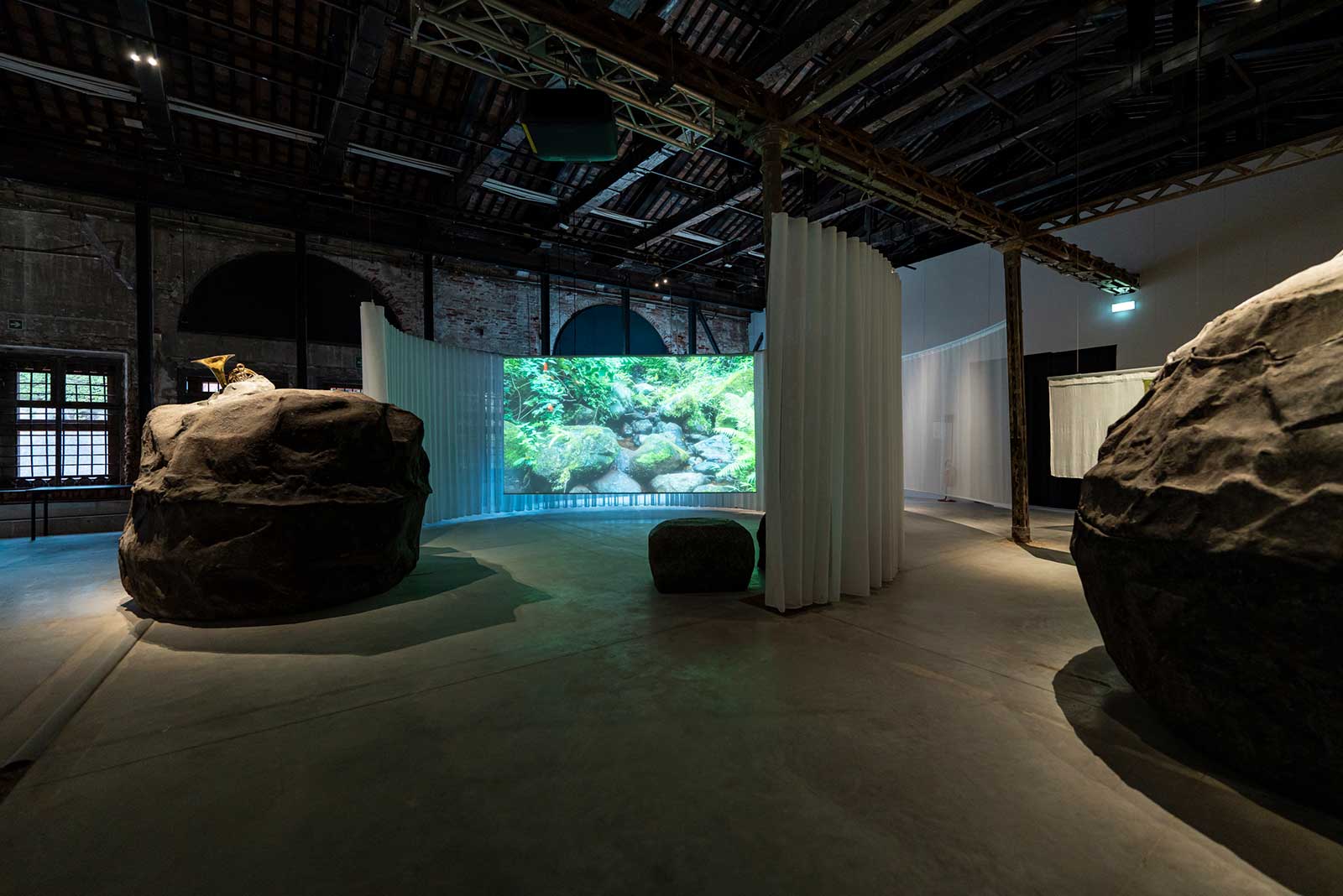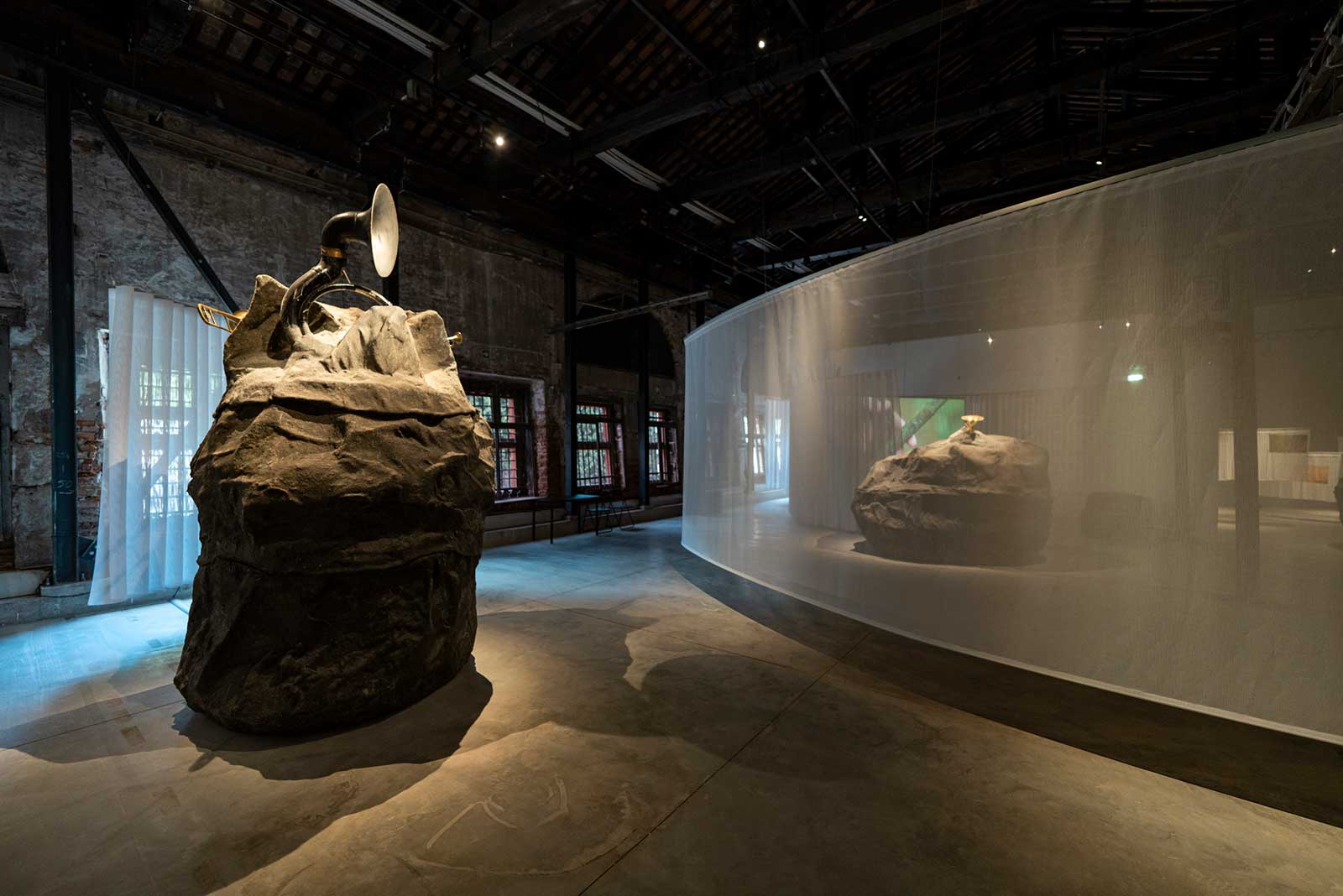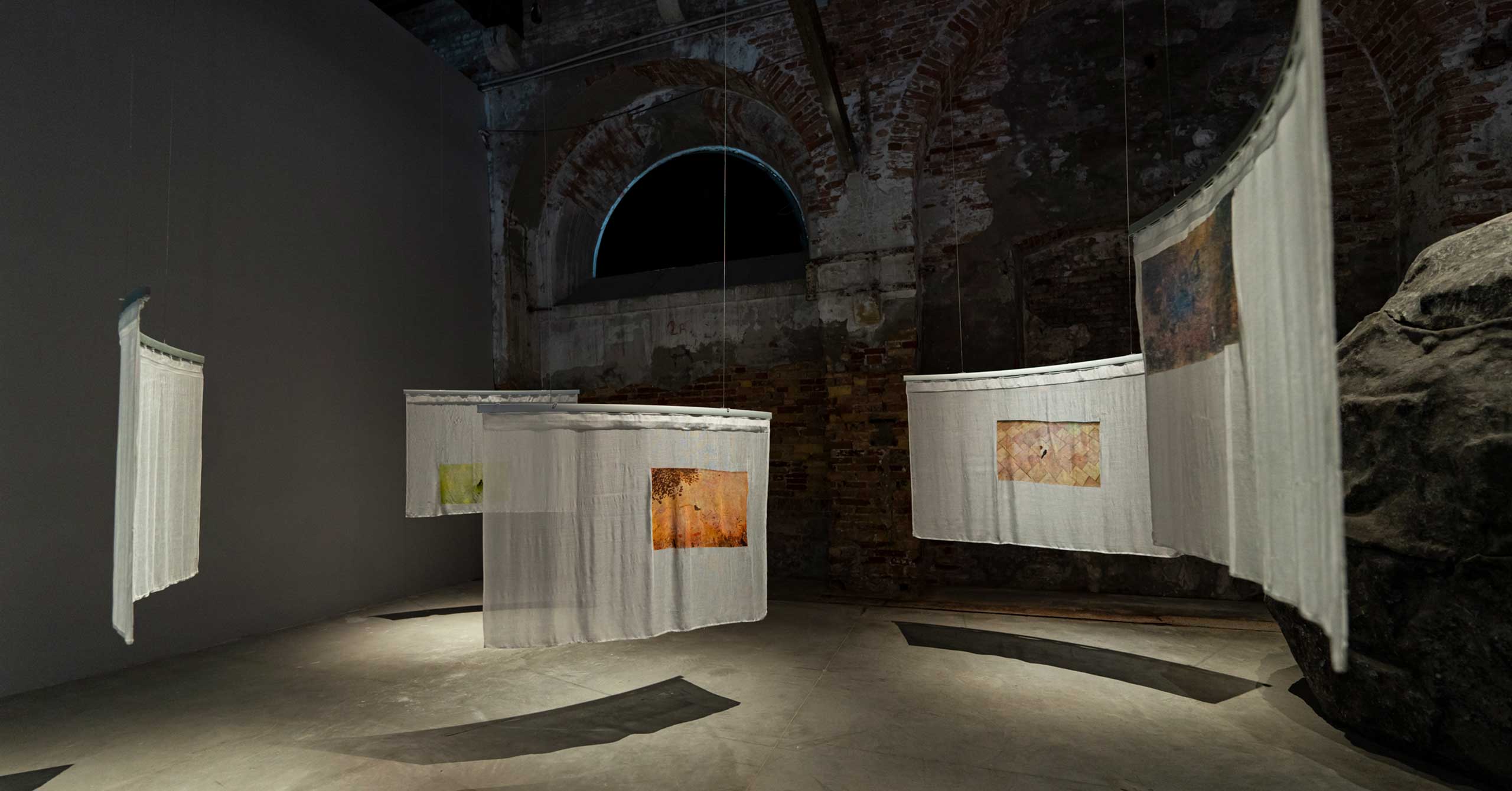Photo by Andrea D’Altoe
Photo by Andrea D’Altoe
The Philippine Pavilion brings a mystical mountain to the Venice Biennale.
In the stories of old, things always seem to take place in the forest. Folk tales and fables from across the Philippines tell of creatures that roam the jungle and spirits that protect the mountains.
In was on the slopes of Mt. Banahaw where the lay priest and mystic Hermano Puli led pilgrimages as the leader of the Cofradia de San Jose, and where he sought refuge as Spanish troops hunted him and his followers down in 1841. Puli, more than just a folk hero in the annals of Philippine history, is also credited as being an early source of inspiration for the events that led to the Cavite Revolt of 1872, a link that the movie GomBurZa clearly makes.
In April 2024, the magic of Mt. Banahaw was transported to the lagoon city of Venice, itself a miraculous mirage built on top of over a hundred smaller islands—a former maritime empire, slowly sinking to the very sea that has brought it untold riches in the medieval period. At the 60th La Biennale di Venezia, the Philippines, a regular participant since its return to the scene in 2015, presented Sa kabila ng tabing lamang sa panahong ito/Waiting just behind the curtain of this age, the country’s national pavilion curated by Carlos Quijon Jr. with the artist Mark Salvatus.
That same month, a contingent from the Philippines almost didn’t make it to the pavilion’s official opening—some of their luggage certainly didn’t—when an unexpected deluge swept through the transit hub of Dubai, causing havoc and delays on flight paths around the world.


As a first-time pilgrim to this Mt. Olympus of the art world, I was overwhelmed and overcome by the scale of it all. How such a compact, condensed city can be filled to the last inch with art, spanning the contemporary to the ancient. How was one to visit each national pavilion—a shrine to 86 individual countries—in the span of a few days, on foot, a customized camino aided by Google Maps and fueled (sometimes hindered) by a fleet of Aperol Spritzes. And how to take in and appreciate the visual sensory overload, when one has only known rare encounters with great works of art?
It just wasn’t possible. I crossed countless bridges and squeezed through nameless alleyways triangulating between the Giardini and the Arsenale, the two main exhibition areas of the Biennale, and my Airbnb in Cannaregio, but after 60,000 steps in three days, my body seemed to shut down, and my brain along with it. The Venice Biennale is called the Olympics because it takes an athlete to navigate, but I also find similarities—especially during the opening—with Disneyland, having to wait in long lines to get into some of the more popular country pavilions, which seem to be segregated along real-world geopolitical lines.

Amid all this, the Philippine pavilion, which is found at the rear of the Arsenale between Ireland and Lebanon, was a respite. And that is how the curator intended it to be: a breath of Mt. Banahaw. Large boulders constructed from fiberglass are placed along a path, scrimmed with white curtains that are referred to in the pavilion’s title. Puli’s religious brotherhood was a group for and by peasant indios, whose unsanctioned activities and growing popularity alarmed the Spanish clergy who used their religious authority to control the population.
“Sa kabila ng tabing lamang sa panahong ito” is attributed to a speech Hermano Puli gave his men as they were about to face down the Spanish military. Victory, he said, will be revealed to those who held the faith. Puli was eventually captured and killed, his body dismembered and displayed around Lucban.
“Puli’s revolution was unfinished, but I am interested in extending his imagination of the world through my art making. For Puli, a curtain was a metaphor for the anticipation that you are about to touch your dream and hope after a long journey and struggles,” says Salvatus. “In reference to Puli’s curtains, I envisioned my work for the Pavilion as a rehearsal for the future—the future that might not come, but that keeps us hopeful.”
Emanating from the boulders or the “batong buhay” (living rocks) is a soundscape that captures the natural music of the mountains, the sound of birds and insects reverberating in thick foliage, punctuated with random noises like a cough, a cat’s meow, and a horn blow, all of which have the startling effect of shifting your body’s awareness, as one viewer commented.

Brass instruments, alluding to the marching bands of Lucban that Salvatus grew up listening to protrude from the rocks like mutant plants. A film shows individual musicians playing brass and wind instruments in Mt. Banahaw. Salvatus had asked the musicians to play instinctively, instructing them to respond to the energy of the mountain.
In the video, a saxophone transforms into a long branch, a trombone turns into a giant leaf. He explains that the boulders, instruments, video, prints, and sound elements are assembled to “reflect the entanglement of the imagination, beliefs, and persistence of our ancestors and ours.”
Persistence is the invisible scaffolding that has enabled the Philippines to rebuild its pavilions after a 51-year absence. The Philippines first participated in the Biennale in 1964 with a small room featuring the works of Jose Joya and Napoleon Abueva, both of whom are now National Artists. But the country was never again seen in the Biennale after that, possibly because it was too expensive to mount.
In 2013, Senator Loren Legarda visited the Venice Biennale for the first time and saw that countries like the Ivory Coast, the Maldives, and Kosovo were participating. “Why is the Philippines not in the Venice Biennale?” the senator wondered.
She took this question to the budget hearings of the Department of Foreign Affairs and embarked on the narrow road to bring the Philippines back. Convincing them of the need for the Philippines to engage with the international community on a cultural level, the DFA and the National Commission for Culture and the Arts agreed to work on the Philippines’ entry to the Biennale in 2015. Sen. Legarda initiated an open call for curatorial proposals, gathering 16 submissions.
A panel of judges, including Mami Kataoka, chief curator of the Mori Art Museum in Tokyo, multimedia artist Paul Pfeiffer, Renaud Proch, executive director of Independent Curators International, Filipino art critic Cid Reyes, then-chairman of NCCA Felipe M. de Leon, Jr., and Sen. Legarda decided on Dr. Patrick Flores’ proposal, the West Philippine Sea-themed Tie a String Around the World.
But before this ship could set sail for the shoals of Venice, the dream had to hurdle setbacks like Typhoon Yolanda and the challenge of finding a palazzo to exhibit in (Sen. Legarda’s inquiries were rebuffed by questions about whether the Philippines can afford to rent a space.) “It’s not a matter of money,” she says. “It’s a matter really of dogged determination.”

The comeback pavilion of the Philippines, installed in a small room of the Palazzo Mora, showed the senator’s more skeptical colleagues in the government just how culture is tied in with political and security issues: Tie a String Around the World presented “Shoal,” Jose Tence Ruiz’ spectral red ship that referenced the BRP Sierra Madre, while Manny Montelibano’s film “A Dashed State” juxtaposed the sound of intruding radio frequencies from Chinese vessels with scenes of fishermen in Southern Palawan, two works that responded to Manuel Conde’s 1950s film Genghis Khan.
“Art and culture weaves us together, binds us as a nation, whether it’s indigenous, traditional, contemporary, modernist,” Se. Legarda says. “You cannot dissociate art and culture from education, from environment, from agriculture, from security, from politics. Everything we’re doing evokes, reflects, seeps into what will become culture.”
From the Palazzo Mora to the Arsenale, nine years later. Salvatus is no stranger to Venice, having participated in the Philippines’ first foray to the Architecture Biennale of 2016. His longtime fascination with the figure of Hermano Puli, his deep ties to Lucban (his grandfather was a poet whose muse was the mountain), and even his near-UFO experience in the area all coalesced into this assemblage proposed for the 60th La Biennale di Venezia, whose theme is the timely Stranieri Ovunque—Foreigners Everywhere. Hermano Puli, Catholic mystic and mountain man, was both shunned and feared by the colonizers. He was a foreigner in his own land, but one who saw beyond the veil.

“I was inspired by Puli’s gentle but sneaky approach to revolution. He inserted himself into the Catholic system. He did not use a sword that sparked a series of revolutionary struggles led by other known heroes like Rizal and Gomburza,” says Salvatus. “He called for a revolution from within (loob) using folk traditions of agimat and pasyon and by coming together. By assembly of bodies and spirits, we can hold our hopes and dreams if we want.”
In Venice, the life of Hermano Puli may be too far a world away for most visitors to comprehend. But the spirit of the forest mountain can touch anyone, if only they listen.
- Renewal and Reinvention In Saudi Arabia: Exploring the 2024 Diriyah Contemporary Art Biennale
- Filipino Photographer Michael Varcas Achieves Regional Win in the 2024 World Press Photo Contest
- Anthea Hamilton on Making Sense of Everyday Objects, The Speed of Fashion, and Her Mixed Heritage
- Award-Winning Designer Ito Kish On His Seasonal Retail Space And His Return to Manila FAME
